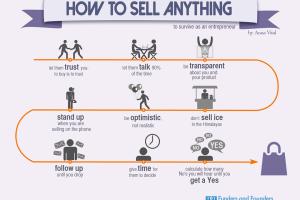Ultimate Guide on Selling Products: Strategies for Success

-
Quick Links:
- 1. Introduction
- 2. Understanding Your Product
- 3. Identifying Your Target Market
- 4. Creating a Sales Strategy
- 5. Leveraging Online Platforms
- 6. Building a Brand
- 7. Effective Promotion Techniques
- 8. Measuring Success
- 9. Case Studies
- 10. Expert Insights
- 11. FAQs
1. Introduction
In today's competitive market, knowing how to sell a product effectively is crucial for success. Whether you're a small business owner, an entrepreneur, or just someone looking to make a profit, understanding the nuances of selling can elevate your efforts significantly. This comprehensive guide will delve into various strategies, techniques, and insights on how to successfully sell a product.
2. Understanding Your Product
The first step in selling a product is to have a deep understanding of what you're selling. This includes:
- Product Features: Know your product inside out. What are its features? What makes it unique?
- Benefits: Understand how your product solves problems for potential customers.
- Pricing: Determine a competitive yet profitable price point.
3. Identifying Your Target Market
Identifying your target market is essential for effective selling. Start by asking yourself:
- Who will benefit most from my product?
- What demographics do my ideal customers belong to (age, gender, income level)?
- What are the interests and behaviors of my target audience?
Using tools like Google Analytics and social media insights can help gather this data.
4. Creating a Sales Strategy
A solid sales strategy outlines how you plan to sell your product. Consider these components:
- Sales Channels: Will you sell online, in-store, or both?
- Sales Process: Define the steps customers go through from awareness to purchase.
- Sales Goals: Set specific, measurable goals to track progress.
5. Leveraging Online Platforms
In the digital age, online platforms play a vital role in sales. Here are some effective ways to leverage them:
- E-commerce Websites: Create an online store using platforms like Shopify or WooCommerce.
- Social Media: Utilize platforms like Instagram and Facebook to engage customers.
- Email Marketing: Build an email list and send targeted promotions.
6. Building a Brand
Branding is more than just a logo; it’s about creating an identity that resonates with customers. Consider the following:
- Brand Message: Clearly articulate what your brand stands for.
- Visual Identity: Develop consistent visual elements that represent your brand.
- Customer Experience: Ensure a positive experience at every touchpoint.
7. Effective Promotion Techniques
Promotion is crucial for driving sales. Here are some techniques to consider:
- Content Marketing: Create valuable content that educates and informs your audience.
- Influencer Marketing: Partner with influencers relevant to your niche.
- Discounts and Offers: Create limited-time offers to encourage quick purchases.
8. Measuring Success
To know if your selling efforts are effective, you need to measure success. Key performance indicators (KPIs) to track include:
- Sales Volume
- Conversion Rates
- Customer Acquisition Costs
9. Case Studies
Examining successful businesses can provide valuable insights. Here are a couple of notable case studies:
Case Study 1: Dollar Shave Club
Dollar Shave Club revolutionized the grooming industry with a subscription model and viral marketing. Their humorous video ad went viral, showcasing the effectiveness of creative marketing.
Case Study 2: Warby Parker
Warby Parker disrupted the eyewear market with their home try-on program, allowing customers to test products before buying, enhancing customer satisfaction and reducing returns.
10. Expert Insights
Industry experts weigh in on best practices for selling products:
"Understanding your customer is key to tailoring your sales approach effectively." - John Doe, Marketing Expert
"Don't underestimate the power of storytelling in sales; it creates emotional connections." - Jane Smith, Sales Strategist
11. FAQs
1. What is the best way to sell a product online?
Utilize e-commerce platforms, engage with customers on social media, and implement effective SEO strategies to drive traffic to your store.
2. How can I improve my sales skills?
Practice active listening, understand your product thoroughly, and engage in role-playing exercises to enhance your selling techniques.
3. What are some common mistakes to avoid when selling a product?
Common mistakes include not knowing your audience, failing to follow up with leads, and not measuring your sales performance.
4. How important is customer feedback in sales?
Customer feedback is crucial as it helps you understand customer needs and improve your product accordingly.
5. What role does pricing play in selling?
Pricing can significantly impact sales; it should reflect the value of the product while remaining competitive in the market.
6. How can I effectively promote my product?
Utilize a mix of online marketing strategies such as SEO, social media marketing, and email campaigns to reach your target audience effectively.
7. Is it better to sell products in bulk or individually?
It depends on your business model; bulk sales can lower the cost per unit, while individual sales can maximize profit margins.
8. What are some tips for closing a sale?
Build rapport with the customer, address objections confidently, and create a sense of urgency to encourage them to make a decision.
9. How can I use social media to sell my products?
Create engaging content, run targeted ads, and interact with customers to promote your products effectively on social media platforms.
10. What is the importance of a strong sales strategy?
A strong sales strategy helps you focus your efforts, track performance, and adapt to changes in the market effectively.